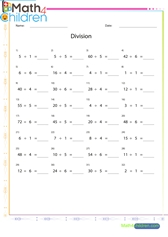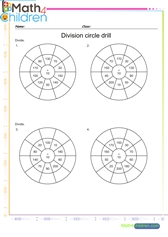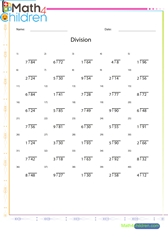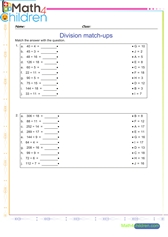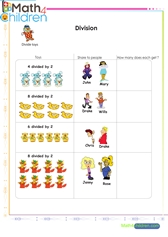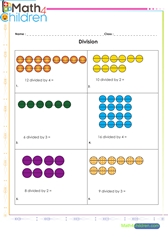![]()
Why division by zero is not possible | Why zero cannot be divided
Division is one of the fundamental operations in mathematics, but have you ever wondered why division by zero is not possible? In this article, we will explore the concept of division, the reasons why division by zero is undefined, the consequences of attempting to divide by zero, and real-life applications that highlight the importance of this concept. So let's dive in and uncover the mystery of why division by zero is not possible!
Table of Contents
- Introduction
- Understanding Division
- Why Division by Zero is Not Possible
- Consequences of Division by Zero
- Real-life Applications
- FAQ
- Conclusion
- References

Understanding Division
Before we delve into why division by zero is not possible, let's first review the basic concept of division. Division is the process of dividing a quantity or a number into equal parts. It is the inverse operation of multiplication and is denoted by the division symbol ("/") or by using the fraction bar ("÷"). The number being divided is called the dividend, and the number by which it is divided is called the divisor. The result of division is called the quotient.
For example, if we have a dividend of 10 and a divisor of 2, the division operation would be expressed as 10 ÷ 2 = 5, where 10 is the dividend, 2 is the divisor, and 5 is the quotient.
Division is used in various mathematical operations, such as calculating ratios, finding averages, solving equations, and more. It is a fundamental concept that is widely used in everyday life, in fields such as science, engineering, finance, and many others.
Why Division by Zero is Not Possible
Division by zero is undefined and not possible in mathematics. This is because division is essentially the process of distributing a quantity or a number into equal parts. However, dividing by zero implies the existence of an equal part of zero, which is a mathematical contradiction and cannot be defined.
To understand why division by zero is not possible, let's consider a simple example. If we have a dividend of 10 and a divisor of 0, the division operation would be expressed as 10 ÷ 0. However, this division is not possible, as it implies finding the number of equal parts of zero that can be obtained from 10. But since zero represents the absence of quantity, there are no equal parts of zero, and the division is undefined.
Mathematically, division by zero is not defined because it violates the basic principles of mathematics, such as the concept of division as distributing into equal parts and the idea of dividing by zero as obtaining an equal part of zero. It leads to inconsistent and contradictory results, and it is not considered a valid mathematical operation.
Consequences of Division by Zero
Attempting to divide by zero can have serious consequences in mathematical calculations and real-life applications. Here are some of the consequences of division by zero:
- Undefined Result: As mentioned earlier, division by zero is undefined, and it does not result in a valid mathematical output. It can lead to errors, inconsistencies, and contradictions in calculations, which can further affect the accuracy and reliability of the results.
- Mathematical Errors: Division by zero can lead to mathematical errors, such as division by zero in equations, formulas, or expressions, which can result in incorrect solutions or answers. This can cause confusion, misinterpretation, and misrepresentation of data or information.
- Logical Inconsistencies: Division by zero can lead to logical inconsistencies in mathematical reasoning and deductions. It can violate the principles of logic, such as the law of non-contradiction and the law of excluded middle, which are the fundamental rules of logical reasoning.
- System Failure: In real-life applications, such as computer programming, engineering calculations, financial modeling, and scientific simulations, division by zero can cause system failures, crashes, or errors. This can disrupt the functionality and performance of the systems and can have severe consequences, including financial losses, safety hazards, or operational failures.
Real-life Applications
The consequences of division by zero are not limited to theoretical mathematics, but they also have practical implications in real-life applications. Here are some examples of real-life applications where division by zero is not possible:
- Finance and Economics: In financial calculations, such as calculating interest rates, investment returns, or risk assessments, division by zero is not possible. It can lead to inaccurate financial projections, misleading investment decisions, and potential financial losses.
- Engineering and Physics: In engineering and physics calculations, such as calculating velocities, forces, or energies, division by zero is not possible.It can result in unrealistic or unattainable results, and can impact the design, performance, and safety of engineering systems, such as bridges, buildings, aircraft, and vehicles.
- Computer Science and Programming: In computer programming, division by zero is not allowed as it can result in runtime errors, crashes, or unexpected behaviors in software applications. It is a common source of bugs and can affect the functionality and reliability of software systems.
- Scientific Research: In scientific research, such as data analysis, modeling, or simulations, division by zero is not possible as it can lead to incorrect interpretations, misleading conclusions, or invalid results. It is essential to follow proper mathematical principles and avoid division by zero in scientific investigations.
- Education and Learning: In mathematics education, division by zero is considered an important concept to understand why it is not possible. Teaching the consequences of division by zero helps students develop critical thinking, logical reasoning, and mathematical skills. It reinforces the fundamental principles of mathematics and promotes a deep understanding of mathematical concepts.
FAQ Section
Here are some frequently asked questions (FAQs) related to division by zero:
Q: Why is division by zero undefined?
A: Division by zero is undefined because it leads to contradictory and inconsistent results. It violates the basic principles of mathematics, such as the concept of division as distributing into equal parts, and the idea of obtaining an equal part of zero. It does not result in a valid mathematical output and is not considered a valid mathematical operation.
Q: What are the consequences of division by zero?
A: The consequences of division by zero include undefined results, mathematical errors, logical inconsistencies, and system failures. It can lead to inaccurate calculations, misleading conclusions, and potential errors in real-life applications, such as finance, engineering, computer programming, and scientific research.
Q: Can I ever divide by zero?
A: No, division by zero is not possible and not allowed in mathematics or any real-life application. It is considered an undefined operation and can lead to incorrect results, logical inconsistencies, and system failures. It is important to avoid division by zero and follow proper mathematical principles in all calculations and applications.
Conclusion
In conclusion, division by zero is not possible in mathematics or any real-life application due to the undefined nature and consequences it entails. It violates the basic principles of mathematics, leads to contradictory and inconsistent results, and can have serious implications in various fields, such as finance, engineering, computer programming, and scientific research. Understanding why division by zero is not possible is essential for accurate mathematical calculations, logical reasoning, and reliable results in all aspects of life.

